South West Water Shellfish Waters NEP AMP6 Programme (2018)
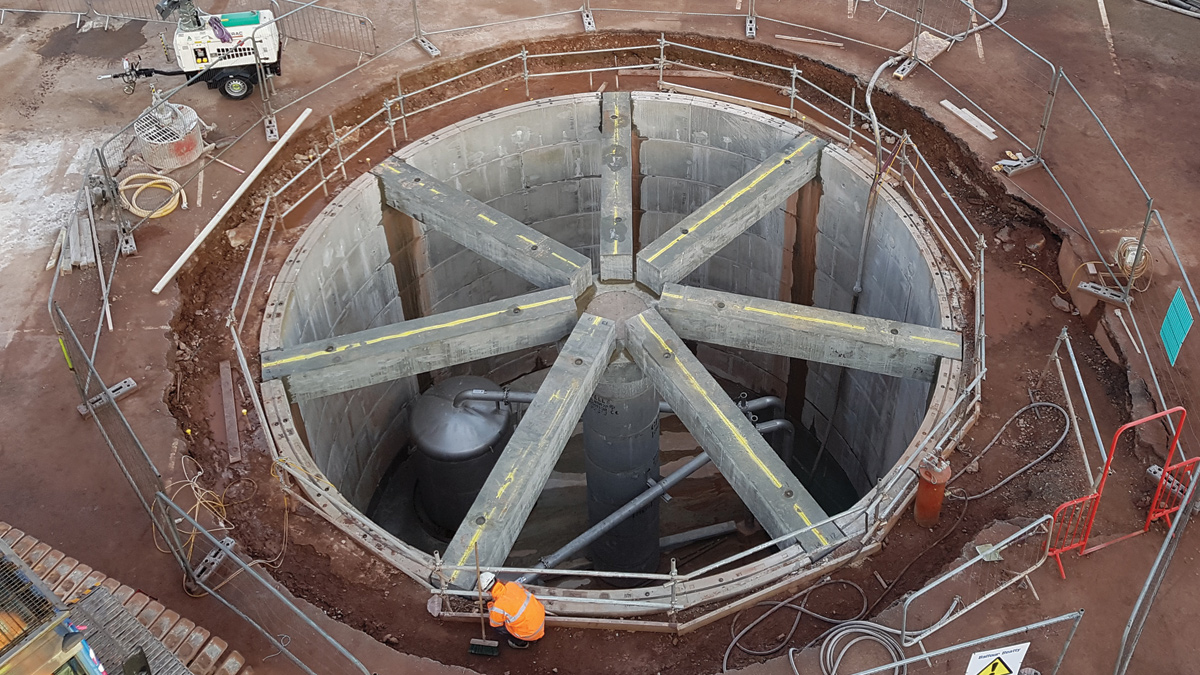
Lympstone storm attenuation shaft - Courtesy of SWW Delivery Alliance H5O
The 2010 Shellfish Waters Directive placed a new obligation on South West Water (SWW) to endeavour to meet the Shellfish Waters Regulations ‘Guideline’ Standard. (Class B). The Shellfish Waters (SFW) programme of work was to meet legislative requirements to protect or improve designated shellfish waters to support shellfish life and growth, contributing to the quality of shellfish products produced in commercial shell fisheries. The investment has helped SWW to deliver its commitment for reducing pollution incidents and in doing so support our regional community and economy.
Background
At PR14 the National Environmental Programme (NEP) identified a Phase 1 programme valued at £120m. This was agreed to be unaffordable for the business and there would be a non-cost beneficial customer willingness to pay. Further investigations and discussions with the Environment Agency (EA) reduced the programme in phases from the initial £120m to an acceptable agreed Phase 5 value of £26m.
The Phase 5 programme identified high priority catchments in the region which involved storm discharge improvements at 28 locations across eight estuary catchments.
Development
The initial objective was based on a maximum of ten spills per year (agglomerated) >50m3 or improved discharge quality. By challenging the original outputs through modelling and combined sewer overflows (CSO) impact assessments, three of the sites have proved to be compliant and therefore removed from the list.
The modelling review also identified significant reductions in scope at many sites, specifically where storm storage solutions were originally proposed. Wherever possible, sustainable solutions have been developed using the principles in South West Water’s Design Hierarchy as detailed below.
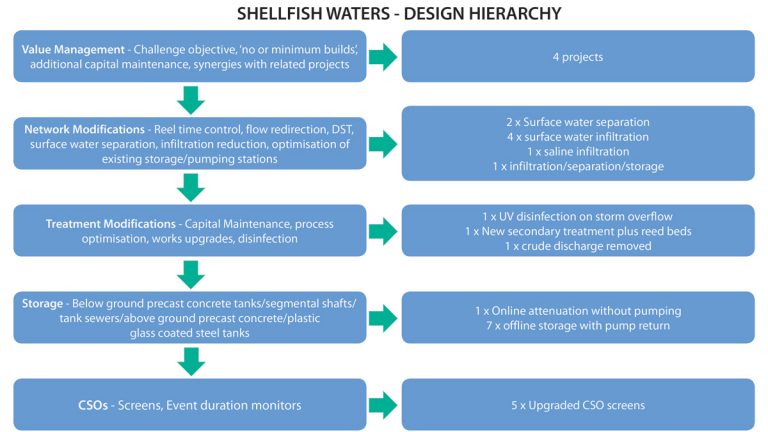
Shellfish Waters design hierarchy
Project delivery
The above scope of works included two projects which involved removal of surface water infiltration, both of which had funding for second phases depending on how successful the first phases were in reducing infiltration. Both phase 1 projects were successful negating the need for further work.
Delivery model
The work was cost effectively delivered through the H5O Delivery Alliance with eleven projects being delivered through the Tier 1 partner contractors and thirteen through the Tier 2 contractors. The works were delivered as a package under the Alliances SIPi arrangements, the overall package with H5O was £18,980k with projects ranging from £70k to £3,650k.
Example case studies
All 24 projects were completed prior to the NEP compliance date 31 March 2018. The following four case studies are examples of the work undertaken.
Lympstone: Infiltration removal, new screen and storage
The objective of the Lympstone Foreshore Shellfish Programme was to contribute towards improving the water quality in the Exe Estuary, in order to protect and enhance shellfish populations. The final output of the project (agreed with the EA) was to achieve a reduction in CSO spills from the Lympstone catchment to less than 10 significant spills per annum. Spill quality was also to be improved with the upgrade of screening to reliable automatically raked, 6mm 2D screening.
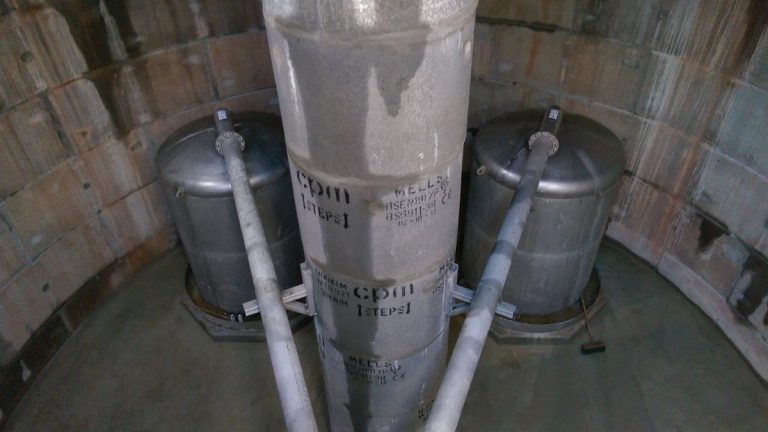
Lympstone storm attenuation shaft: showing twin flushing bells and the central support column – Courtesy of SWW Delivery Alliance H5O
The scheme solution comprised catchment infiltration removal, construction of an additional 600m3 attenuation capacity and automatically raked 6mm 2D screening on the outfall. The infiltration removal was achieved with a combination of sewer lining, dig down repairs and manhole sealing. Attenuation was provided in a 10.5m diameter, 9.5m deep shaft with inlet screening, a flushing system and a pumped return. The outfall screen was a 1m long, 90°, hydraulically raked MecMex unit, installed in the existing overflow chamber in Outfall SPS.
The total project forecast value is £2,179,127. Project commenced in July 2017 and was completed February 2018. It included working with the Parish Council to overcome issues with local traffic and parking, which included the construction of a remote contractor’s compound and a temporary car park to compensate for spaces displaced by the main construction compound.
Countess Wear UV
Under the Shellfish Directive, SWW was challenged to improve water quality by reducing E. coli. Countess Wear STW was identified as the most significant bacterial point sources for improvement on the Exe Estuary.
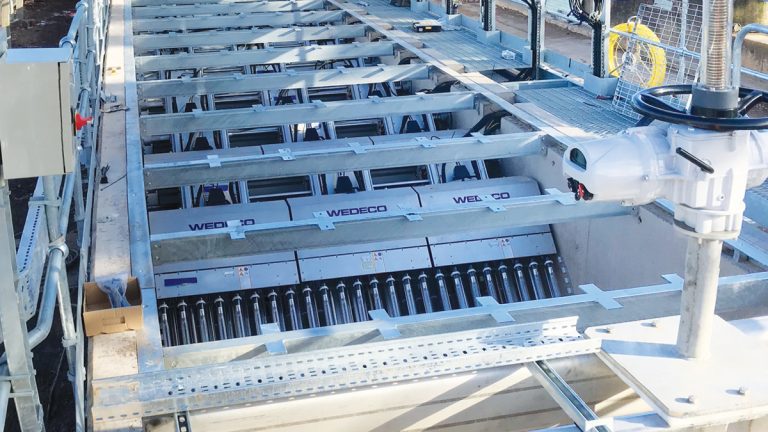
Wedeco UV disinfection system at Countess Wear – Courtesy of SWW Delivery Alliance H5O
With limited space at the treatment works and a drive for sustainable alternatives to traditional storage solutions, ultraviolet (UV) stormwater disinfection for 1340 l/s incorporating a Wedeco UV disinfection system and modified discharge outfall was proposed.
At the site, the complex existing storm storage arrangement, coupled with an extremely constrained site and abundance of services, meant that the proposed UV system was eventually located along the site boundary, being built into the existing site flood defence barrier.
Due to the intermittent discharges at the treatment works, the flows were highly variable. The Fluid Group was commissioned to produce a computational fluid dynamics (CFD) model to verify the hydraulic calculations. To comply with the Environment Agency’s recently introduced validated dose methodology, H5O managed input from an industry expert who was fully familiar with the EA permitting process.
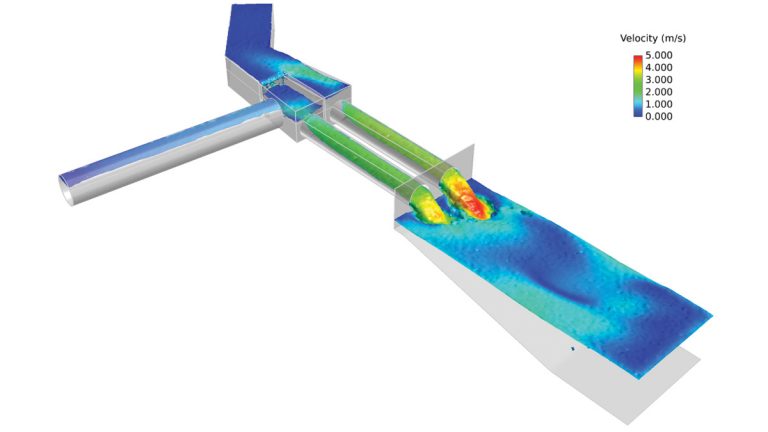
CFD model of the modified gross overflow outfall to accept additional storm UV flows – Courtesy of SWW Delivery Alliance H5O
Chudleigh Surface Water Separation Scheme (SWSS)
The objective of the Chudleigh SWSS was to reduce the CSO spills to the river Teign, which impacts on the Teign Estuary and shellfish beds. Chudleigh is an historic old town in Devon which, typical to most old towns had a majority combined sewer system within the main town. During the optioneering phase, it was identified that by removing surface water from the three main streets into Chudleigh, the CSO spills reduced significantly. A new surface water system for Chudleigh was designed utilising a mixture of new and existing surface water sewers.
Surface water removal provides multiple benefits; it removes unnecessary surface water from the combined system, reducing treatment and processing costs and it also provides additional capacity within the combined system.
In addition to the provision of a new surface water system, rainwater gardens are being provided within the town car park, providing some attenuation on the surface water system, to help remove peaks on storm events which could produce flooding on larger events. The raingardens will also provide some visual enhancement to the existing car parking, with the local council agreeing to take on the role of planting and upkeep.
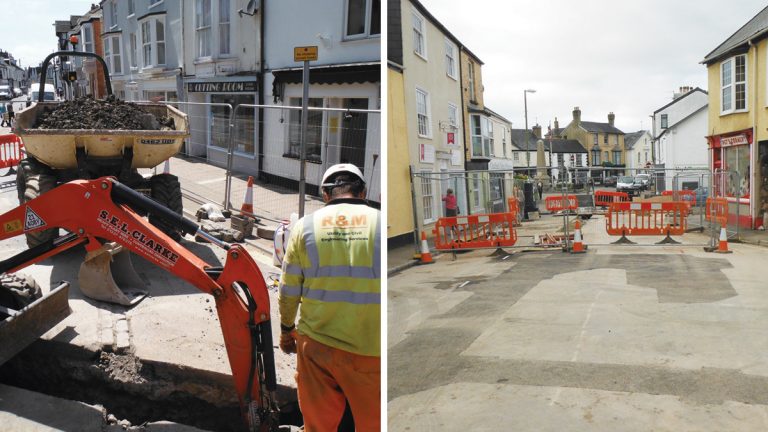
Typical Roads within Chudleigh, Devon where new surface water system needed to be installed – Courtesy of SWW Delivery Alliance H5O
A final additional benefit of the scheme was through engagement with the local council during the design phase; the opportunity to provide some rainwater harvesting for the Town Hall in the form of a rainwater harvesting tank providing rainwater reuse for flushing the toilets in the building which houses the local council, the local preschool and community rooms.
Mill Creek SPS CSO
The Mill Creek Sewage Pumping Station (SPS) CSO scheme was the upgrade of the overflow screening arrangement within the existing compound (which has challenging access) using a pre-fabricated option. The SPS compound is within the picturesque village of Dittisham in the South Hams which has tourist interest.
A major challenge to the scheme was the constrained footprint of the site and limited access. A description of the terrain adjoining the site is below.
- North: A riverside woodland.
- East: A retaining wall and steep land continuing to rise above.
- South: Private gardens.
- West: The River Dart.
Consideration was given to accessing the site via barge, but this option did not offer good value for the scale of work and would have necessitated removal of mature riverside trees. A private garden was identified as an appropriate option with reasonable road access and gradient; the lower part of this garden was being used as an orchard.
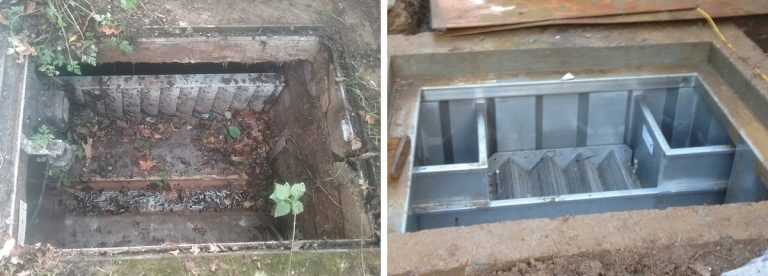
(left) Original Mill Creek vertical bar screen and (right) The Mill Creek pre-fabricated chamber in situ – Courtesy of SWW Delivery Alliance H5O
The existing CSO chamber was too small to accommodate a new screen so extension or a new chamber was required. A pre-fabricated option (complete with screen) was promoted to ease the installation of the new chamber in a constrained site and reduce the on-site programme, reducing the impact on the land owner.
The principal designer and principal contractor worked closely with the pre-fabricators to achieve a compact design that met the performance needs and was practical regarding the installation process. The new chamber was installed off line despite limited space within the SPS compound. Up front survey work including topographical and utility survey (including ground penetrating radar) aided the design process to achieve this. A good working relationship between the principal designer and principal contractor facilitated alterations to suit the as found conditions once excavation had started.
Access to the site via the privately-owned garden was critical to the adopted approach. Careful and considerate negotiation was undertaken by the delivery alliance to agree access dates, duration and compensation with the owner. Expectations were managed via frequent informal updates from the site team and periodic updates from the client’s estates manager.
The scheme was programmed for a winter delivery to reduce impact on the village during the busy summer months. The team worked effectively by engaging with stakeholders and suppliers to value engineer the scheme and deliver it with minimum impact.








